Epstein-Barr virus nuclear antigen 1 Hijacks the host kinase CK2 to disrupt PML nuclear bodies
- PMID: 20719947
- PMCID: PMC2953151
- DOI: 10.1128/JVI.01183-10
Epstein-Barr virus nuclear antigen 1 Hijacks the host kinase CK2 to disrupt PML nuclear bodies
Abstract
Latent Epstein-Barr virus (EBV) infection is an important causative factor in the development of several cancers, including nasopharyngeal carcinoma (NPC). The one EBV protein expressed in the nucleus of NPC cells, EBNA1, has been shown to disrupt promyelocitic leukemia (PML) nuclear bodies (NBs) by inducing the degradation of PML proteins, leading to impaired DNA repair and increased cell survival. Although EBNA1-mediated PML disruption is likely to be an important factor in the development of NPC, little is known about its mechanism. We now show that an interaction between EBNA1 and the host CK2 kinase is crucial for EBNA1 to disrupt PML bodies and degrade PML proteins. EBNA1 increases the association of CK2 with PML proteins, thereby increasing the phosphorylation of PML proteins by CK2, a modification that is known to trigger the polyubiquitylation and degradation of PML. The interaction between EBNA1 and CK2 is direct and occurs through the β regulatory subunit of CK2 and EBNA1 amino acids 387 to 394. The binding of EBNA1 to the host ubiquitin specific protease USP7 has also been shown to be important for EBNA1-mediated PML disruption. We show that EBNA1 also increases the occupancy of USP7 at PML NBs and that CK2 and USP7 bind independently and simultaneously to EBNA1 to form a ternary complex. The combined results indicate that EBNA1 usurps two independent cellular pathways to trigger the loss of PML NBs.
Figures
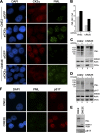
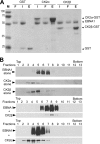
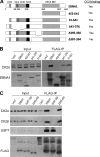

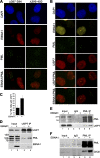
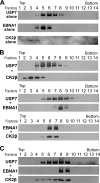

Similar articles
-
Viral disruption of promyelocytic leukemia (PML) nuclear bodies by hijacking host PML regulators.Virulence. 2011 Jan-Feb;2(1):58-62. doi: 10.4161/viru.2.1.14610. Epub 2011 Jan 1. Virulence. 2011. PMID: 21217204
-
Epstein-Barr nuclear antigen 1 contributes to nasopharyngeal carcinoma through disruption of PML nuclear bodies.PLoS Pathog. 2008 Oct 3;4(10):e1000170. doi: 10.1371/journal.ppat.1000170. PLoS Pathog. 2008. PMID: 18833293 Free PMC article.
-
Contributions of the Epstein-Barr virus EBNA1 protein to gastric carcinoma.J Virol. 2012 Jan;86(1):60-8. doi: 10.1128/JVI.05623-11. Epub 2011 Oct 19. J Virol. 2012. PMID: 22013060 Free PMC article.
-
Contributions of Epstein-Barr nuclear antigen 1 (EBNA1) to cell immortalization and survival.Viruses. 2012 Sep;4(9):1537-1547. doi: 10.3390/v4091537. Epub 2012 Sep 13. Viruses. 2012. PMID: 23170171 Free PMC article. Review.
-
Role of EBNA1 in NPC tumourigenesis.Semin Cancer Biol. 2012 Apr;22(2):154-61. doi: 10.1016/j.semcancer.2011.12.002. Epub 2011 Dec 22. Semin Cancer Biol. 2012. PMID: 22206863 Review.
Cited by
-
TRIMming Type I Interferon-Mediated Innate Immune Response in Antiviral and Antitumor Defense.Viruses. 2021 Feb 11;13(2):279. doi: 10.3390/v13020279. Viruses. 2021. PMID: 33670221 Free PMC article. Review.
-
Investigating genetic-and-epigenetic networks, and the cellular mechanisms occurring in Epstein-Barr virus-infected human B lymphocytes via big data mining and genome-wide two-sided NGS data identification.PLoS One. 2018 Aug 22;13(8):e0202537. doi: 10.1371/journal.pone.0202537. eCollection 2018. PLoS One. 2018. PMID: 30133498 Free PMC article.
-
Proteomic profiling of the human cytomegalovirus UL35 gene products reveals a role for UL35 in the DNA repair response.J Virol. 2012 Jan;86(2):806-20. doi: 10.1128/JVI.05442-11. Epub 2011 Nov 9. J Virol. 2012. PMID: 22072767 Free PMC article.
-
Carcinoma-risk variant of EBNA1 deregulates Epstein-Barr Virus episomal latency.Oncotarget. 2017 Jan 31;8(5):7248-7264. doi: 10.18632/oncotarget.14540. Oncotarget. 2017. PMID: 28077791 Free PMC article.
-
The regulatory role of protein phosphorylation in human gammaherpesvirus associated cancers.Virol Sin. 2017 Oct;32(5):357-368. doi: 10.1007/s12250-017-4081-9. Epub 2017 Oct 30. Virol Sin. 2017. PMID: 29116588 Free PMC article. Review.
References
-
- Appel, K., P. Wagner, B. Boldyreff, O. G. Issinger, and M. Montenarh. 1995. Mapping of the interaction sites of the growth suppressor protein p53 with the regulatory beta-subunit of protein kinase CK2. Oncogene 11:1971-1978. - PubMed
Publication types
MeSH terms
Substances
Grants and funding
LinkOut - more resources
Full Text Sources
Other Literature Sources
Molecular Biology Databases
Research Materials
Miscellaneous

